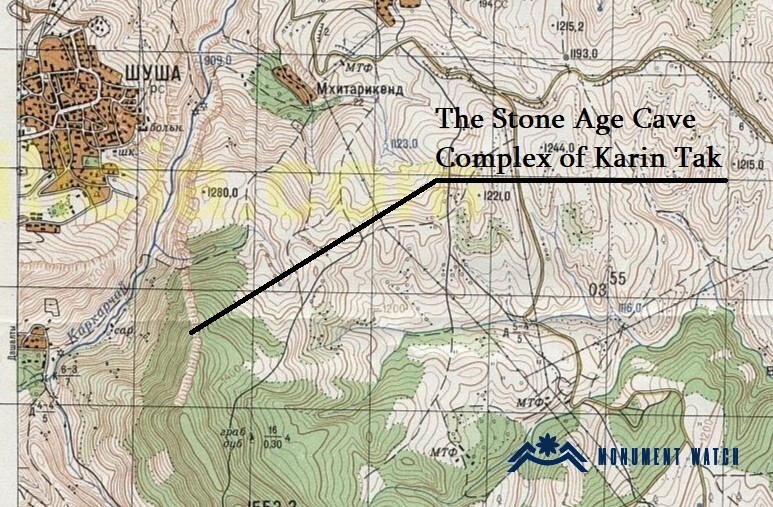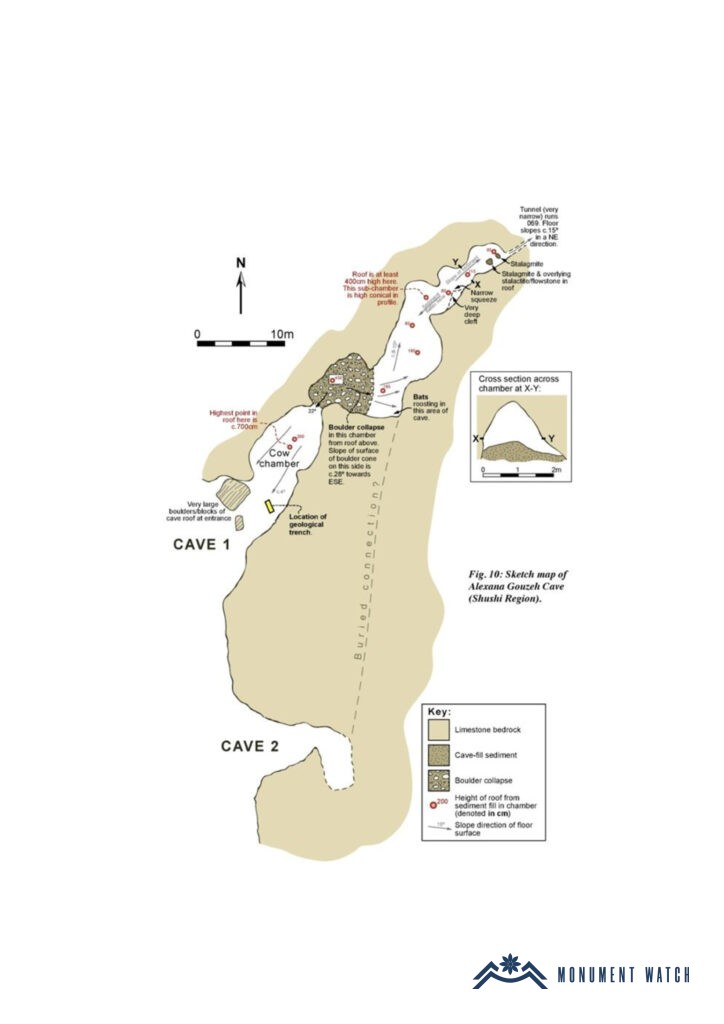The Stone Age Cave Complex of Karin Tak
Location
The Karin Tak Cave is located near the village of Karintak in the Shushi region of the Republic of Artsakh. Situated within the Karintak Forest on the right bank of the Karkar River (Fig. 1), the cave complex is notable for its archaeological significance dating back to the Stone Age. Since 2020, the area has been under Azerbaijani occupation.
Historical overview
The Karin Tak Cave has been mentioned by M. Barkhutaryants and E. Lalayan in their respective works (Barkhutareants 1895, 135; Lalayan 1897, 18).
The Karin Tak Cave research project was undertaken to characterize ancient human migrations, settlement patterns, biodiversity, and climate in the Lesser Caucasus during the Pleistocene and Holocene epochs (approximately 2.6 million years ago to the present).
The Karin Tak Cave Complex is pivotal for reconstructing prehistoric migrations from Africa and the colonization of Asia and Europe. Situated within a key geographic corridor (Fig. 2), it likely served as a passageway for modern humans and their early ancestors moving between Africa, Europe, and Asia. Furthermore, archaeological findings at the site have yielded evidence of various European and African fauna, underscoring its significance in understanding ancient biodiversity and migration patterns (Report 2019, 38).
Archaeological Examination
In 2016, an international expedition comprising relevant specialists commenced large-scale excavations at the ancient site. These efforts continued during the field seasons from 2017 to 2020 under the direction of Expedition Head Levon Episkoposyan. The excavations revealed a continuous sequence of cultural layers dating from the Middle Stone Age to the Copper Age. During fieldwork in the cave, the team unearthed an extensive collection of fossil bones, with the total number exceeding 20,000 specimens (Antonosyan, 2021, 67).
The 2016 fieldwork results included a comprehensive geological analysis of the cave, revealing its underlying geological structure and stratigraphy (Report 2017, 50; Fig. 3). The site yielded over 1,000 fossil bones representing a diverse range of organisms, including large mammals such as bovids (hollow-horned cattle) and porcupines; invertebrates like bivalves; microfauna such as small rodents and insectivores; as well as birds and fish. Notably, two human teeth were also recovered from the site. Additionally, an obsidian tool was discovered (Figs. 4, 5).
During the 2017 excavations, modern and systematic archaeological techniques were employed, with measures taken to prevent contamination. Three-dimensional documentation of the findings was conducted to facilitate an understanding of the spatial and temporal distribution of the recovered materials. To locate smaller fossils, dry sieving of the sedimentary layers was performed (Figs. 6, 7). Furthermore, a detailed geological study of the cave was undertaken.
During the 2018 fieldwork, a total of 8,500 fossil bones were recovered, along with charcoal remnants and coprolites. The majority of these bones are small fragments, with complete specimens being exceedingly rare. The morphologically identifiable assemblage is predominantly represented by small mammals, with clavicles, mandibles, and vertebrae constituting the majority of identifiable remains. The remains of large mammals are primarily represented by teeth, phalanges, and diaphyses of long bones. Additionally, the fossil assemblage includes fish vertebrae and bird claws. Notably, a human bone was also discovered.
The excavated samples were systematically cleaned and preliminarily identified daily in the field laboratory (Fig. 8). To prevent DNA degradation, the sediment layers were dried without exposure to direct sunlight (Fig. 9). The dried sediment layers underwent dry sieving on-site, utilizing two sieve sizes, with a minimum mesh opening of 0.5 mm, facilitating the recovery of small fossil remains (Fig. 10).
Between 2017 and 2019, over 100 fossil seeds were recovered from the excavation areas of the Karin Tak Cave. Morphological identification of the plant remains was carried out in the paleobotany laboratory at the Institute of Botany, part of the National Academy of Sciences of the Republic of Armenia (Report 2018).
The Karin Tak Cave is a significant archaeological site, providing invaluable insights into the region's ancient environment, early human settlement, and ecological adaptations since the Paleolithic era. Additionally, the application of contemporary molecular techniques holds the potential to further illuminate this data, enabling a comprehensive understanding of the distant past (Antonosyan, 2021, 71).
The condition before and after the war
Prior to the war, the monument was well-preserved and in good condition. However, following the complete depopulation of Artsakh in September 2023, the area fell under Azerbaijani control. Currently, there is no available information regarding the status of the monument.
Bibliography
- Barkhutareants 1895 - Barkhutareants M. Artsakh, Baku.
- Lalayan 1897 - E. Lalayan, Varanda, "Ethnological journal", book 2, Tiflis.
- Antonosyan 2021 - Antonosyan M., Stanton D., Amano N., Episkoposyan L, Assessment of molecular preservation in the bone material of Karin Tak cave, NAS RA reports, N 1.
- Report 2017 - 2017 Report of the Karin Tak Expedition.
- Report 2018 - 2018 Report of the Karin Tak Expedition.
- Report 2019 - 2019 Report of the Karin Tak Expedition.
The Stone Age Cave Complex of Karin Tak
Artsakh










